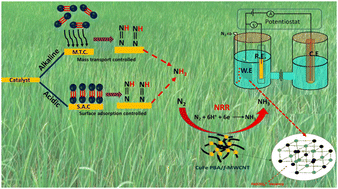Mechanistic insights into the electrolyte effects on the electrochemical nitrogen reduction reaction using copper hexacyanoferrate/f-MWCNT nano-composites†
Abstract
Developing an efficient, selective, and stable electrocatalysis system for the electrocatalytic N2 reduction reaction (ENRR) is a promising strategy for the green and sustainable production of ammonia. The activity, selectivity, and stability of various electrocatalysts in different electrolyte solvents, mainly acidic and alkaline electrolytes, are commonly compared in the literature. However, a mechanistic insight into the effect of these electrolytes on ENRR activity is lacking. Herein we demonstrate that the acidity or alkalinity of the electrolyte is a key factor in determining the rate-limiting step and, by extension, the ENRR performance of an electrochemical setup for the electroproduction of ammonia. Our results from ex situ X-ray photoelectron, Raman, and FTIR spectroscopy analysis of the fresh and spent Cu-hexacyanoferrate Prussian blue analogue-decorated functionalized carbon nanotube (CuFe PBA/f-CNT) catalyst reveal that NH4+-species are more strongly adsorbed on the catalyst surface during the ENRR in acidic than in alkaline electrolytes. The results of our detailed rotating ring-disc electrode voltammetry studies suggest that the ENRR over CuFe PBA/f-CNT is mostly controlled by surface adsorption in an acidic electrolyte and by mass transport in an alkaline electrolyte. In situ Raman spectroscopy confirms this finding and shows that the leaching of Fe(CN)6 species from the CuFe PBA/f-CNT composite in an alkaline electrolyte greatly affects the ENRR performance. We believe that the work presented herein offers a new insight into the mechanistic aspects of the ENRR in different electrolyte systems and hence can prove very valuable for the development of effective ENRR electrode/electrolyte systems for practical applications.

- This article is part of the themed collection: 2023 PCCP HOT Articles


 Please wait while we load your content...
Please wait while we load your content...